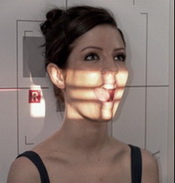IR Size: 8x10 LW
SID: 60-72''
• Pt TLP
• Chin slightly elevated & protruded
• Shoulders in same plane
• (Center shadow on center AEC)
• _|_ to C4 (thyroid cartilage); Top of light to TEA; (Can rotate CR head & collimate)
•
• 10''
• Suspend on Exhalation (or use sandbags)
• Zygapophyseal joints & Spinous processes in profile
• All 7 C vertebrae & at least 1/3 of T1
• SI mandibular rami
• Neck extended so mandibular rami not SI over atlas or axis
• NR or tilt of the cervical spine by SI open zygapophyseal joints & intervertebral disk spaces
• Spinous processes in profile
• C4 in the center of the radiograph




IR Size: 8x10 LW
SID: 60-72''
• Body (& head) 45°, head slightly turned to IR
• Chin slightly extended
• LPO 1st then RPO 2nd
• (PA Axial may be used except change CR 15°-20° caudad)
• to C4 (thyroid cartilage)
• 15°-20° cephalad
• 10''
• Suspend
• Open intervertebral foramina & pedicles farthest from IR (in PA closest to IR)
•
• Open intervertebral foramina farthest from the IR, from C2-3 to C7-T1
• Open intervertebral disk spaces
• Uniform size & contour of the foramina
• Elevated chin that does not overlap the atlas and axis
• No SI of Occipital bone on the axis
• Cl-7 and Tl




IR Size: 8x10 LW
SID: 40''
• Pt supine or erect
• Chin extended
• PA may be used except change CR 15°-20° caudad
• (Light Top of Ear TEA)
• to C4 (thyroid cartilage)
• 15°-20° cephalad
• 10''
• Suspend
• C3-C7 & intervertebral disk spaces & presence/absence of cervical ribs
• Line from upper occlusal plane to mastoid tip _|_
• C3-T2 visualized, Open disk spaces
• Spinous process equidistant to pedicles
• Mandibular angles & mastoid processes equidistant to the vertebrae
• Shadows of the mandible and occiput SI over the atlas & most of the axis




IR Size: 8x10 LW
SID: 40''
• Pt supine or erect, Mouth open wide
• Pt softly ''ah''
• [If Occipital base SI dens-tilt pt chin downward, If upper incisors SI on dens-tip pt chin upward][If all three SI use Fuchs]
• _|_ to mid open mouth
•
• tight
• Suspend
• Atlas & Axis
• Lateral masses of C1, No SI of tongue
• Entire tip of Dens, Open entire atlantoaxial joint
• SI of occlusal plane of upper incisors & base of skull
• Mandibular rami equidistant from dens




IR Size: 8x10 CW
SID: 40''
• Pt supine
• _|_ to level of mastoid tips
•
• tight
• Suspend
• Dens within circular foramen magnum
• NR of head & neck
• Entire dens within foramen magnum




IR Size: 10x12 LW
SID: 60-72''
• Rule out Fracture and pathology 1st
• Positioning like lateral except:
• Hyperflexion-drop head forward as close to chest as possible
• Hyperextension-elevate chin as much as possible
• _|_ to C4 (thyroid cartilage); Top of light to TEA; Can rotate CR head & collimate
•
•
• Shows motility of C-Spine



